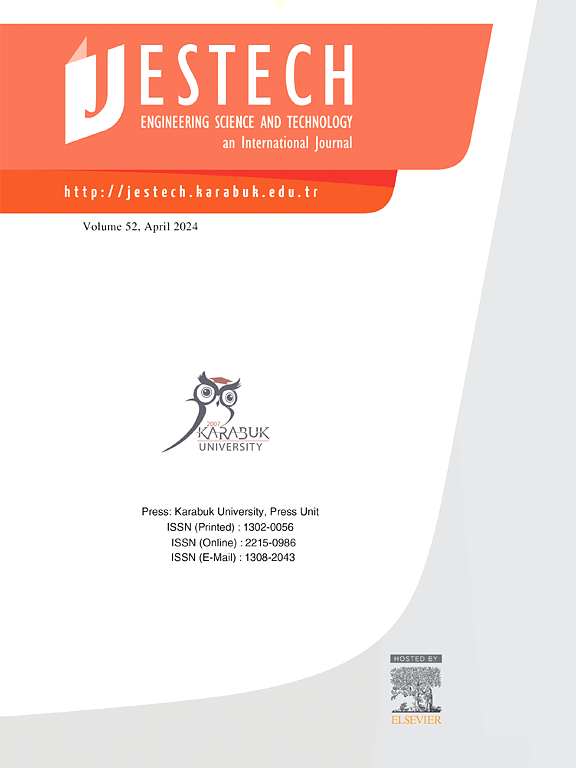A dual-band microwave sensor for glucose measurements utilizing an enclosed split ring metamaterial-based array
IF 5.1
2区 工程技术
Q1 ENGINEERING, MULTIDISCIPLINARY
Engineering Science and Technology-An International Journal-Jestech
Pub Date : 2025-02-01
DOI:10.1016/j.jestch.2025.101947
引用次数: 0
Abstract
Diabetes is currently a major public health concern, partly exacerbated by the recent outbreak of coronavirus. Most of the published EM-wave based glucose sensors of this date allow a glucose concentration to be determined through a resonance frequency shift, inevitably with a questionable accuracy. To overcome the accuracy problem, a dual-band glucose sensor with dimensions 50 mm × 20 mm is proposed in this work to enable a glucose concentration to be measured at one resonance frequency band and cross-checked at another. An array of split-ring resonators (SRRs) was fabricated at a rectangular sensing area on the top surface of a 0.3 mm thick PET substrate, forming a metasurface with dual resonance bands at 4.5 GHz and 9.2 GHz. The backside of the PET substrate was fabricated with a defected ground plane designed to suppress the Q-factor associated with 4.5 GHz while leaving the Q-factor associated with 9.2 GHz unchanged. During a glucose concentration measurement, a drop of glucose solution was applied to the rectangular metasurface sensing area. The glucose concentration was determined in the form of a resonance frequency shift of the reflection coefficient at 4.5 GHz and a magnitude change of the reflection coefficient at 9.2 GHz. Consistent with our theoretical prediction, the fabricated sensor has indeed exhibited a dual resonant band characteristics, with one resonance occurring at 4.5 GHz and the other at 9.2 GHz. By measuring the reflection coefficient near 4.5 GHz, a positive and linear correlation in the log scale was observed between the glucose concentration and the resonant frequency shift with a sensitivity of 0.6 . At 9.2 GHz, there was no significant resonant frequency shift with varying glucose concentrations, but the magnitude of the reflection coefficient changed with the glucose concentration nonlinearly in an amount-dependent manner, with a sensitivity of 16.6 dB per unit glucose concentration within the clinical diabetic range. Overall, the log scale of the glucose concentration has exhibited a positive and linear correlation within the clinical diabetic range with both the resonant frequency shift at 4.5 GHz and the magnitude change at 9.2 GHz, thereby allowing the glucose concentration to be measured at 4.5 GHz and further cross-checked at 9.2 GHz at the same time.
一种用于葡萄糖测量的双频微波传感器,利用封闭的分裂环超材料阵列
糖尿病目前是一个主要的公共卫生问题,最近爆发的冠状病毒在一定程度上加剧了这一问题。大多数已发表的基于电磁波的葡萄糖传感器允许通过共振频移来确定葡萄糖浓度,不可避免地具有可疑的准确性。为了克服精度问题,本研究提出了一种尺寸为50mm × 20mm的双波段葡萄糖传感器,使葡萄糖浓度能够在一个共振频带测量,并在另一个共振频带交叉检查。在0.3 mm厚PET基板顶表面的矩形感应区制备了一组分裂环谐振器,形成了4.5 GHz和9.2 GHz双共振带的超表面。在PET衬底的背面制造了一个有缺陷的接平面,旨在抑制与4.5 GHz相关的q因子,同时保持与9.2 GHz相关的q因子不变。在葡萄糖浓度测量期间,一滴葡萄糖溶液被应用到矩形超表面传感区域。葡萄糖浓度以反射系数在4.5 GHz处的共振频移和反射系数在9.2 GHz处的幅度变化的形式测定。与我们的理论预测一致,制作的传感器确实表现出双共振带特性,一个共振发生在4.5 GHz,另一个共振发生在9.2 GHz。通过在4.5 GHz附近测量反射系数,观察到葡萄糖浓度与谐振频移之间在对数尺度上呈线性正相关,灵敏度为0.6 MHz/(mgdL−1)。在9.2 GHz处,随着葡萄糖浓度的变化,共振频移不明显,但反射系数的大小随葡萄糖浓度呈量依赖的非线性变化,在临床糖尿病范围内,每单位葡萄糖浓度的灵敏度为16.6 dB。总体而言,葡萄糖浓度的对数尺度在糖尿病临床范围内,与4.5 GHz的谐振频移和9.2 GHz的幅度变化都呈现出正线性相关,从而可以在4.5 GHz测量葡萄糖浓度,同时在9.2 GHz进行进一步的交叉检查。
本文章由计算机程序翻译,如有差异,请以英文原文为准。
求助全文
约1分钟内获得全文
求助全文
来源期刊

Engineering Science and Technology-An International Journal-Jestech
Materials Science-Electronic, Optical and Magnetic Materials
CiteScore
11.20
自引率
3.50%
发文量
153
审稿时长
22 days
期刊介绍:
Engineering Science and Technology, an International Journal (JESTECH) (formerly Technology), a peer-reviewed quarterly engineering journal, publishes both theoretical and experimental high quality papers of permanent interest, not previously published in journals, in the field of engineering and applied science which aims to promote the theory and practice of technology and engineering. In addition to peer-reviewed original research papers, the Editorial Board welcomes original research reports, state-of-the-art reviews and communications in the broadly defined field of engineering science and technology.
The scope of JESTECH includes a wide spectrum of subjects including:
-Electrical/Electronics and Computer Engineering (Biomedical Engineering and Instrumentation; Coding, Cryptography, and Information Protection; Communications, Networks, Mobile Computing and Distributed Systems; Compilers and Operating Systems; Computer Architecture, Parallel Processing, and Dependability; Computer Vision and Robotics; Control Theory; Electromagnetic Waves, Microwave Techniques and Antennas; Embedded Systems; Integrated Circuits, VLSI Design, Testing, and CAD; Microelectromechanical Systems; Microelectronics, and Electronic Devices and Circuits; Power, Energy and Energy Conversion Systems; Signal, Image, and Speech Processing)
-Mechanical and Civil Engineering (Automotive Technologies; Biomechanics; Construction Materials; Design and Manufacturing; Dynamics and Control; Energy Generation, Utilization, Conversion, and Storage; Fluid Mechanics and Hydraulics; Heat and Mass Transfer; Micro-Nano Sciences; Renewable and Sustainable Energy Technologies; Robotics and Mechatronics; Solid Mechanics and Structure; Thermal Sciences)
-Metallurgical and Materials Engineering (Advanced Materials Science; Biomaterials; Ceramic and Inorgnanic Materials; Electronic-Magnetic Materials; Energy and Environment; Materials Characterizastion; Metallurgy; Polymers and Nanocomposites)
 求助内容:
求助内容: 应助结果提醒方式:
应助结果提醒方式:


